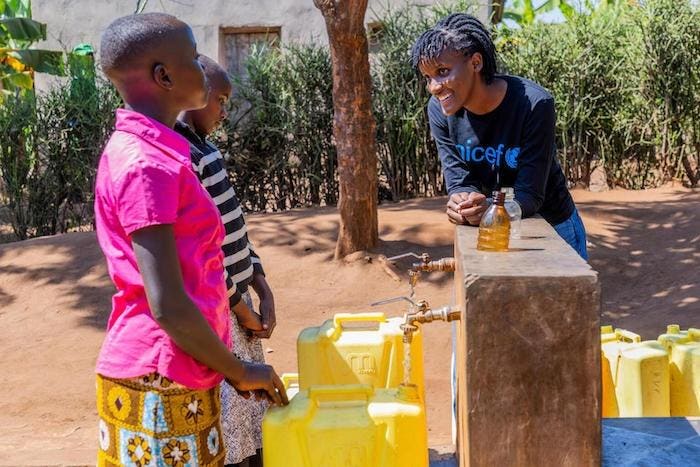Sustainable solar-powered water systems save money, protect communities from climate shocks and ease the water burden for girls.
What’s good for girls is good for the planet
Before the new solar-powered water taps were installed near her home in Kirehe District, Eastern Province, Rwanda, 13-year-old Adele walked for an hour every day before school to fetch water for her family’s daily cooking and washing, a heavy 20-liter jerry can balanced on her head.
At the end of her school day, she repeated the journey. The old water point was far away and isolated; friends of Adele’s had been abused or abducted en route.
The new water point is much closer to home and in a busy area. As part of efforts to promote alternate energy solutions and strengthen climate resilience, UNICEF, in partnership with World Vision and Rwanda Water and Sanitation Corporation, supported the district in the construction of a solar system for the Nyagashankara water supply.
Solar arrays save money and reduce high carbon emissions
Before the switch to solar in May, the system was powered strictly by a diesel generator, like other systems in remote rural areas of Rwanda where there is limited or no access to electricity. The price of using these generators is steep, measured in financial costs as well as high carbon emissions.
An array of 360 solar panels now helps to power the pumps, pushing water through 24 miles of pipeline, 14 water storage tanks, 40 public water taps and 67 household connections. Operation costs have been cut in half and exposure to pollution in the community has been reduced.
The system serves a population of some 22,000 people — 11,000 of them adolescent girls and women — along with seven schools, two health posts and one medical center.
No climate justice without gender justice
On a recent visit to Rwanda, UNICEF Goodwill Ambassador Vanessa Nakate saw firsthand how the new system is making a big impact on the lives of girls in the community.
“Adele told me the new solar-powered site reduces her entire journey to just 25 minutes, making her feel safer and giving her more time to learn and play,” Nakate said. “Girls like Adele do not live single-issue lives, so it’s critical that donors and governments support projects that protect both their rights and their environments.
“There is no climate justice without gender justice,” Nakate added. “Together, climate crises and gender inequality cut across every part of a girl’s life. But in a world where every girl is listened to, I know the world would stand a better chance, both when it comes to the existential threat of climate change, and to becoming a more equal, innovative, powerful, and beautiful place.”
For Rania Dagash, UNICEF Deputy Regional Director for Eastern and Southern Africa, UNICEF’s role is clear: to listen to adolescent girls and women who are demanding action to address climate issues, and to act.
“Despite the stark challenges they face, adolescent girls and women are leading the call for change around the world, building powerful, intersectional movements,” Dagash said. “We know the world needs to do things differently if we are to step up to the scale of this challenge. Girls’ voices must be at the heart of our work.”
UNICEF helps communities respond to the climate crisis to protect, prepare and prioritize children to secure a safe, sustainable and water-secure future. Please donate today.
Read the full article here





